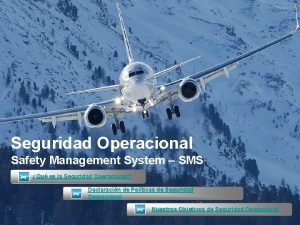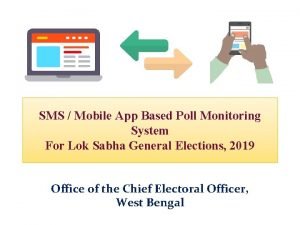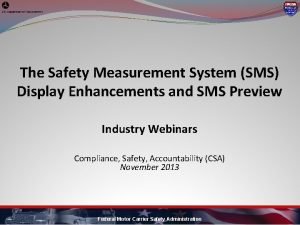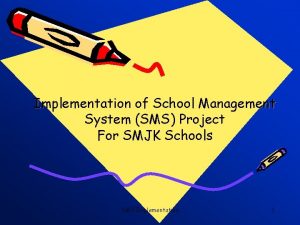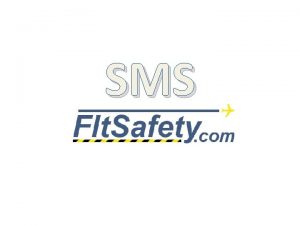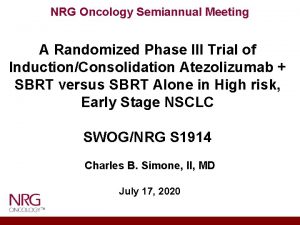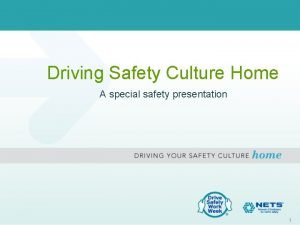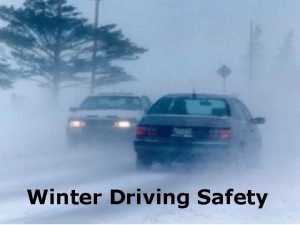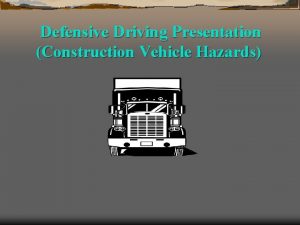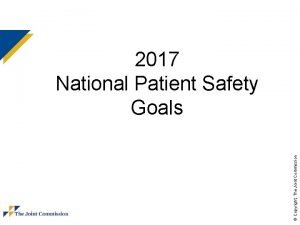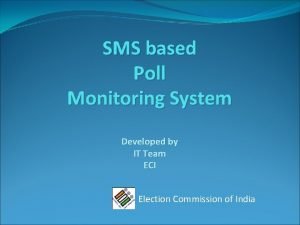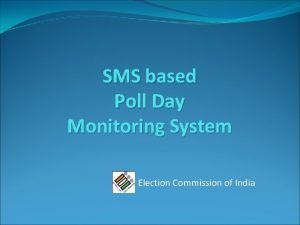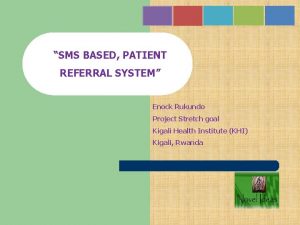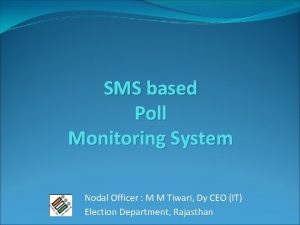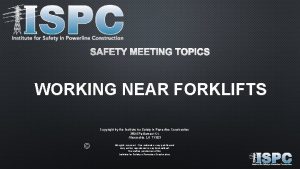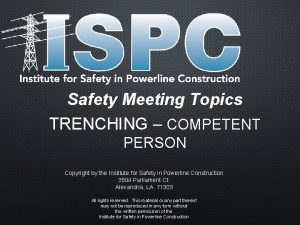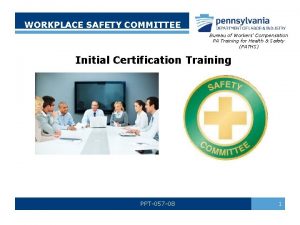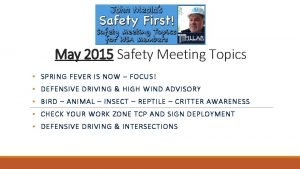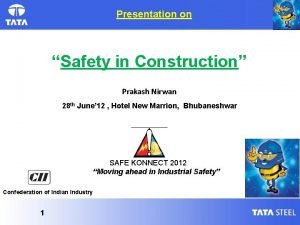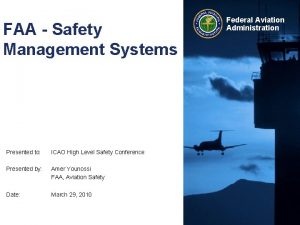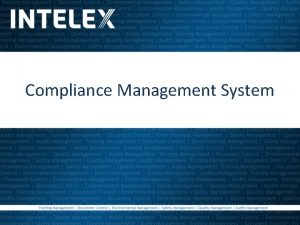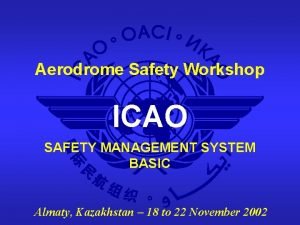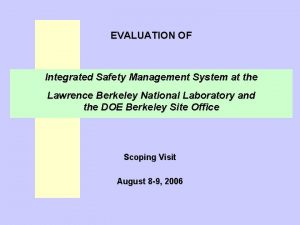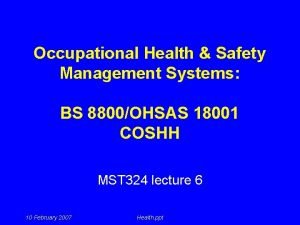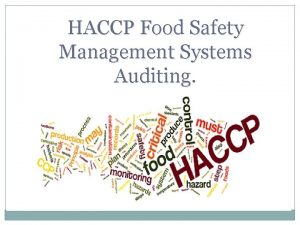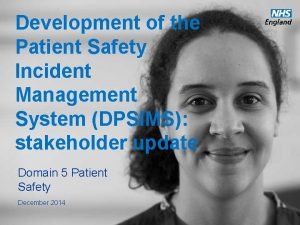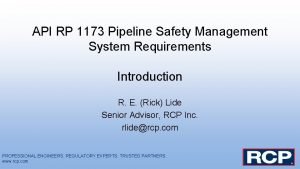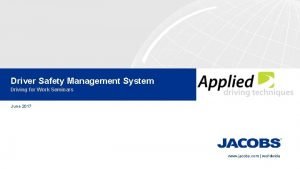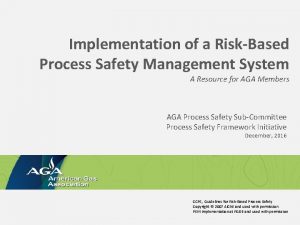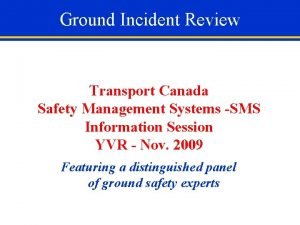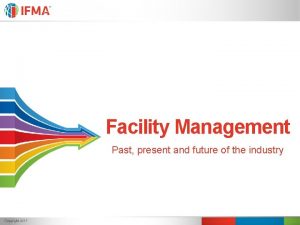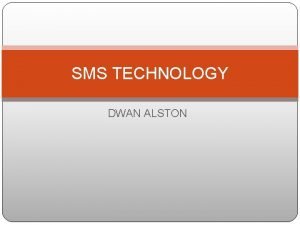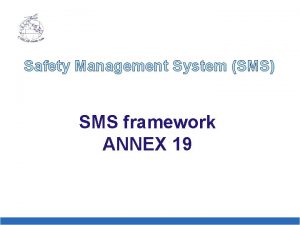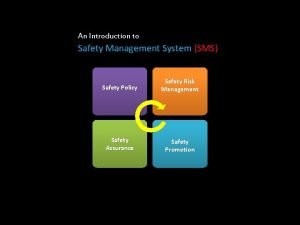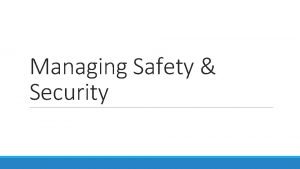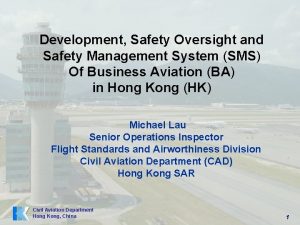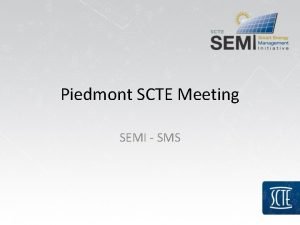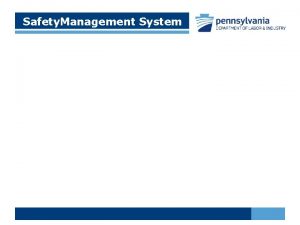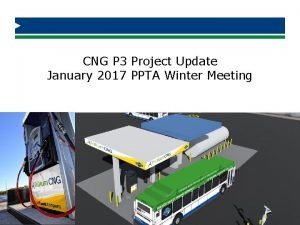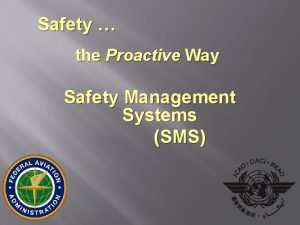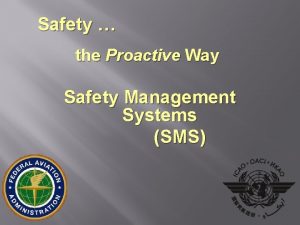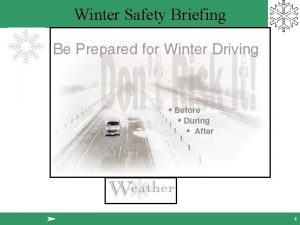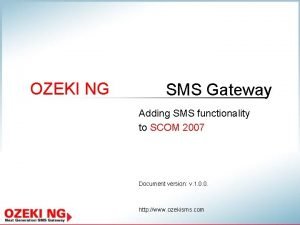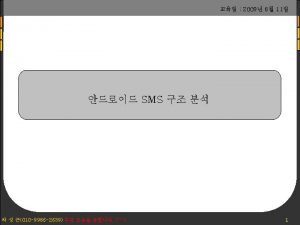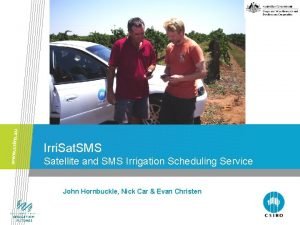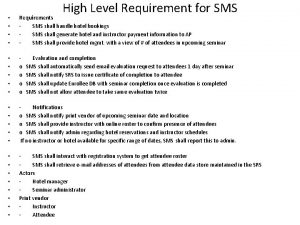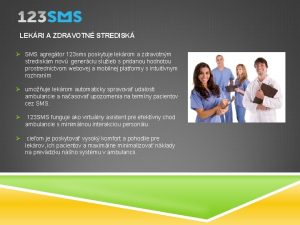Safety Management System SMS 2017 PPTA Winter Meeting





















































- Slides: 53

Safety Management System (SMS) 2017 PPTA Winter Meeting Ream Lazaro, FTA Contractor

Agenda • • • FTA Bus Safety Program Overview Defining SMS and its Benefits Organizational Accident Practical Drift Employee Safety Reporting SMS Framework SMS Roles and Responsibilities SMS Lessons Learned Key SMS Resources Q&A 2

BUS SAFETY PROGRAM OVERVIEW 3

FTA Bus Safety Program • Voluntary onsite reviews • Orientation seminars • Ongoing outreach Voluntary Onsite Reviews Orientation Seminars Industry Coordination and Outreach 4

DEFINING SMS & ITS BENEFITS 5

Managing or Reacting • When we talk about managing safety, are we really “managing” or are we simply “reacting? ” • Transit industry has tended towards being reactive as opposed to proactive • Typically, it wasn’t until an accident or incident occurred that we focused on the safety issue and how to resolve it 6

What is SMS? Formal, top-down, organization-wide, datadriven approach to managing safety risk and assuring effectiveness of safety risk mitigations. Includes systematic policies, procedures, and practices for managing safety risk. 7

SMS in General • A management system • Systematic • Safety management is a core agency function – (e. g. , financial management, HR management, IT management) • Provides decision-making tools for management 8

What SMS does • Ensures timely information about safety risks – Enables executives to make informed decisions about prioritized allocation of safety resources • Actively seeks to identify hazards and mitigate their potential consequences • Fosters system-wide communication about safety issues up, down and across the agency • Improves safety culture by involving frontline employees in hazard identification 9

Five Questions SMS Answers 1. What are our most serious safety concerns? 2. How do we know this? 3. What are we doing about them? 4. Is what we are doing working? 5. How do we know what we are doing is working? 10

THE ORGANIZATIONAL ACCIDENT 11

Two Realities of Accident Causation • Accidents are result of individual failures – Actions/inactions of people • Accidents are result of organization failures – Actions/inactions of organizations 12

Organizational Accidents “Organizational accidents have multiple causes involving many people operating at different levels of their respective companies. ” – Professor James Reason, “Managing the Risks of Organizational Accidents 13

Swiss Cheese Model Organization Workplace People Defenses Safety Breakdown Hazards Some holes due to latent conditions Some holes due to active failures 14

Human Error • Individuals do not cause organizational accidents • Individuals trigger conditions leading to organizational accidents • Organizational accidents have deeper and broader roots 15

“The discovery of human error should be considered the starting point of the investigation, not the ending point. ” - ISASI Forum 16

PRACTICAL DRIFT 17

Practical Drift Defined • A drift from the performance of work as imagined to performance of work as it is actually carried out 18

Imperfect Systems – The Practical Drift “Work as imagined” System and Tasks as designed and engineered Start of Operations Procedure Over Time “Uncoupling of practice from procedure” Why? What happened? Local Reality “Work as actually done” Practical Drift • Service delivery pressures • Procedure no longer practical • Short cuts are more efficient • Supervisor allows it • Informal processes • Training inadequately conveyed risk Practice 19

Navigating the Drift – The Need for Data Baseline Performance Practical Drift Organization Op era The difference between “where we are” and “where we thought we were” tio na l. P erf orm an ce 20

EMPLOYEE SAFETY REPORTING 21

Characteristics of Effective Employee Safety Reporting • • • Employees actually use the system; voluntary reporting increases Employees feel their concerns are being heard and addressed Managers have better understanding of how safe their agency’s operations really are Encourages dialogue and transparency about safety Leads to timely safety improvements Supports development of learning culture versus punitive culture 22

How does a transit agency increase voluntary employee safety reporting? Challenge – Employees will not voluntarily share information if they feel it could lead to a negative outcome Solution – Reduce incentives not to report and increase incentives to report 23

How does a transit agency increase voluntary employee safety reporting? Why don’t employees report? • Not that important Change Incentives to Report • Demonstrate that reporting is valued • Clarify what’s important • Empower employees 24

How does a transit agency increase voluntary employee safety reporting? Why don’t employees report? • Not that important • Affects team’s safety record Change Incentives to Report • Prioritize an accurate safety risk picture • Emphasize benefits for safety, not safety record 25

How does a transit agency increase voluntary employee safety reporting? Why don’t employees report? • Not that important • Affects team’s safety record • Nothing would be done to fix it Change Incentives to Report • Evaluate each report • Follow up and show what was done as a result of reporting 26

How does a transit agency increase voluntary employee safety reporting? Why don’t employees report? • Not that important • Affects team’s safety record • Nothing would be done to fix it • Blame for incident • Treated or disciplined unfairly Change Incentives to Report • Balance learning and accountability • Be consistent – set & follow clear guidelines for unacceptable behavior 27

How does a transit agency increase voluntary employee safety reporting? Human Error At-Risk Behavior Reckless Behavior An inadvertent action – slip, lapse, mistake A choice – risk Conscious not recognized or disregard of believed justified unreasonable risk Manage through: • Processes & procedures • Increase situational awareness • Remedial action • Checklists • Remove incentives for at-risk behavior • Training • Design • Punitive action • Create incentives for safe behavior 28

SMS FRAMEWORK 29

30

SAFETY MANAGEMENT POLICY 31

Safety Management Policy Sub-Components Safety Management Policy Statement Safety Accountabilities & Responsibilities Integration with Public Safety & Emergency Management SMS Documentation & Records 32

SAFETY RISK MANAGEMENT 33

Safety Risk Management Sub-Components Safety Risk Management Hazard Identification & Analysis Safety Risk Evaluation & Mitigation 34

SAFETY ASSURANCE 35

Safety Assurance Sub-Components Safety Assurance Safety performance monitoring & measurement Management of change Continuous improvement 36

SAFETY PROMOTION 37

Safety Promotion Sub-Components Safety Promotion Safety Communication Competencies and Training 38

SMS ROLES AND RESPONSIBILITIES 39

Who is the Accountable Executive • Should be transit agency’s chief executive • At some transit agencies, roles and responsibilities may be fluid based on structure and reporting relationships • Must be one primary decision-maker that is ultimately responsible for safety management • It is a basic management tenet that accountabilities flow top-down 40

Accountable Executive Responsibilities • Ensure safety concerns are considered in ongoing budget planning process • Ensure transparency in safety priorities for oversight entity and employees • Establish guidance on level of acceptable safety risk • Ensure Safety Management Policy Statement is appropriate and communicated throughout agency 41

Appoint the SMS Lead • Must have explicit support from the Accountable Executive • Must have formal access [as per governance structure] to Accountable Executive • Should be formally appointed and trained • For smaller agencies, may be current safety manager • For larger agencies, may be head of Safety Dept. or senior member of Safety Dept. 42

SMS Manager/Key Safety Personnel Responsibilities • Manages SMS implementation plan on behalf of Accountable Executive • Directs hazard identification and safety risk evaluation • Monitors mitigation activities • Provides periodic reports on safety performance • Maintains safety documentation • Plans and organizes safety training • Scale of this function varies depending on size of organization 43

Build the SMS Implementation Team • Must have clearly defined roles and responsibilities • Must be interdisciplinary – Operations and Maintenance departments/functions must be represented • Must have clear tasks to be executed over a specific time period • Supports the SMS Lead • Will vary based on agency size, complexity, and operating characteristics 44

SMS LESSONS LEARNED 45

Key Message for Top Executives • Commitment to SMS is vital for its success – Top Executive must endorse it, resource it and ensure it is used • Communicate often with your employees – Emphasize your safety priorities – Employees more likely to report and discuss safety concerns if it is easy • Integrate SMS into management of all service delivery operations – Improves agency’s ability to address safety concerns across the organization 46

Engage and Empower Key Players • Identify the SMS Lead • Form multi-functional team to draft SMS Implementation Plan • Schedule meetings and training for SMS team members • Ensure SMS team has access to all required information • Emphasize that SMS is everyone’s responsibility 47

Begin with the End in Mind • Define SMS objectives and expectations • Help create an organizational vision of what SMS success will look like • SMS needs to align with your agency’s primary purpose: service delivery • Build on the practices you have in place 48

Make Communication Front and Center • Ensure people understand their SMS roles and responsibilities • Ensure Executive Leadership receives routine SMS updates • Provide regular SMS updates to oversight authority and union leadership (as applicable) 49

Use and Improve the SMS • SMS implementation will not happen all at once • SMS needs time for implementation and to mature • Components of SMS will move from development to operations as they are put into place • SMS will always be a work in progress 50

KEY RESOURCES 51

Key Resources Read, watch, and participate • Review FTA’s SMS Framework at http: //transit. dot. gov • Participate in webinars explaining new regulations and guidance • Visit FTA’s You. Tube page to view previous webinars • Read our newsletter TSO Spotlight Get trained Through FTA’s safety website: • Take the SMS Awareness online course Sign up to receive updates • FTA announcements and new documents • https: //public. govdeli very. com/accounts/U SDOTFTA/subscriber/ new • Sign up for classroom courses • Request an Individual Training Profile (ITP) – Courses based on your role Questions? Comments? Email us at FTASafety. Stakeholder@dot. gov 52

Q&A 53
 Seguridad operacional (sms)
Seguridad operacional (sms) C# bramka sms
C# bramka sms Daytoro
Daytoro Sms safety measurement system
Sms safety measurement system Winter kommt winter kommt flocken fallen nieder
Winter kommt winter kommt flocken fallen nieder Winter kommt winter kommt flocken fallen nieder lied
Winter kommt winter kommt flocken fallen nieder lied Was ist deine lieblingsjahreszeit
Was ist deine lieblingsjahreszeit Ip project on school management system
Ip project on school management system Life cycle of a phoenix
Life cycle of a phoenix Sms safety score
Sms safety score Safety promotion sms
Safety promotion sms Asco 2017 virtual meeting
Asco 2017 virtual meeting Nrg oncology meeting
Nrg oncology meeting Job meeting bari 2017
Job meeting bari 2017 Nrg oncology conference
Nrg oncology conference Nrg oncology semiannual meeting
Nrg oncology semiannual meeting American epilepsy society annual meeting 2017
American epilepsy society annual meeting 2017 Winter driving safety presentation
Winter driving safety presentation Winter safety brief
Winter safety brief Winter driving safety topics
Winter driving safety topics Winter driving safety presentation
Winter driving safety presentation Today meeting or today's meeting
Today meeting or today's meeting Proposal kickoff meeting agenda
Proposal kickoff meeting agenda What is meeting and types of meeting
What is meeting and types of meeting What is meeting and types of meeting
What is meeting and types of meeting National patient safety goals 2017
National patient safety goals 2017 Poll monitoring system
Poll monitoring system Poll day monitoring system
Poll day monitoring system Sms based patient monitoring system
Sms based patient monitoring system Poll monitoring system
Poll monitoring system Forklift safety meeting topics
Forklift safety meeting topics Trenching and excavation safety meeting
Trenching and excavation safety meeting Pa safety committee certification
Pa safety committee certification Safety topics for spring
Safety topics for spring Health and safety management system template
Health and safety management system template Hard barrication standards
Hard barrication standards Safety management system faa
Safety management system faa Intelex document control
Intelex document control Icao safety management system
Icao safety management system What is integrated safety management system
What is integrated safety management system Bs 8800
Bs 8800 Food safety assurance
Food safety assurance Patient safety incident management system
Patient safety incident management system Pipeline safety management system
Pipeline safety management system Driver safety management system
Driver safety management system Ccps process safety elements
Ccps process safety elements Transport canada safety management system
Transport canada safety management system Forrester real time interaction management
Forrester real time interaction management Iso/tr 41013:2017 facility management – scope
Iso/tr 41013:2017 facility management – scope Which display mode is allowed for proper navigation?
Which display mode is allowed for proper navigation? Qbs safety care
Qbs safety care Personal safety vs process safety
Personal safety vs process safety Ind safety report
Ind safety report Basic safety orientation
Basic safety orientation
